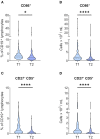B Cell Composition Is Altered After Kidney Transplantation and Transitional B Cells Correlate With SARS-CoV-2 Vaccination Response
- PMID: 35187002
- PMCID: PMC8847739
- DOI: 10.3389/fmed.2022.818882
B Cell Composition Is Altered After Kidney Transplantation and Transitional B Cells Correlate With SARS-CoV-2 Vaccination Response
Abstract
Background: The COVID-19 pandemic has major implications on kidney transplant recipients (KTRs) since they show increased mortality due to impaired immune responses to SARS-CoV-2 infection and a reduced efficacy of SARS-CoV-2 vaccination. Surprisingly, dialysis patients have shown superior seroconversion rates after vaccination compared to KTRs. Therefore, we investigated peripheral blood B cell (BC) composition before and after kidney transplantation (KT) and aimed to screen the BC compartment to explain impaired antibody generation.
Methods: A total of 105 patients were recruited, and multicolor flow cytometric phenotyping of peripheral venous blood BC subpopulations was performed before and 1 year after KT. Complete follow-up was available for 71 individuals. Anti-SARS-CoV-2 antibodies were collected retrospectively and were available for 40 subjects, who had received two doses of an mRNA-based vaccine (BNT162b2 or mRNA-1273).
Results: Overall, relative BC frequencies within lymphocytes decreased, and their absolute counts trended in the same direction 1 year after KT as compared to CKD G5 patients. Frequencies and absolute numbers of naïve BCs remained stable. Frequencies of double negative BCs, a heterogeneous subpopulation of antigen experienced BCs lacking CD27 expression, were increased after KT, yet their absolute counts were similar at both time points. Transitional BCs (TrBCs) and plasmablasts were significantly reduced after KT in absolute and relative terms. Memory BCs were affected differently since class-switched and IgM-only subsets decreased after KT, but unswitched and IgD-only memory BCs remained unchanged. CD86+ and CD5+ expression on BCs was downregulated after KT. Correlational analysis revealed that TrBCs were the only subset to correlate with titer levels after SARS-CoV-2 vaccination. Responders showed higher TrBCs, both absolute and relative, than non-responders.
Conclusion: Together, after 1 year, KTRs showed persistent and profound compositional changes within the BC compartment. Low TrBCs, 1 year after KT, may account for the low serological response to SARS-CoV-2 vaccination in KTRs compared to dialysis patients. Our findings need confirmation in further studies as they may guide vaccination strategies.
Keywords: B cells; CKD G5; COVID-19; SARS-CoV-2 vaccination; kidney transplantation.
Copyright © 2022 Schuller, Pfeifer, Kirsch, Klötzer, Mooslechner, Rosenkranz, Stiegler, Schemmer, Sourij, Eller, Prietl and Eller.
Conflict of interest statement
Authors VP and BP were employed by CBmed GmbH. The remaining authors declare that the research was conducted in the absence of any commercial or financial relationships that could be construed as a potential conflict of interest.
Figures






References
LinkOut - more resources
Full Text Sources
Research Materials
Miscellaneous

